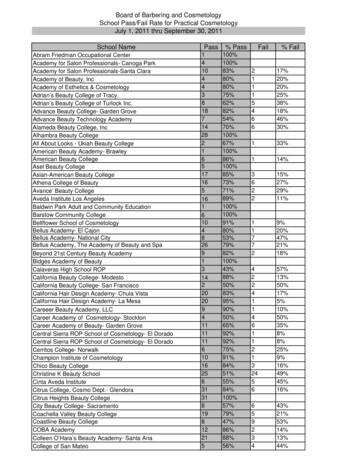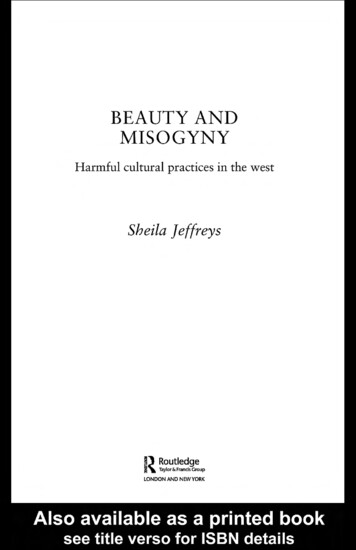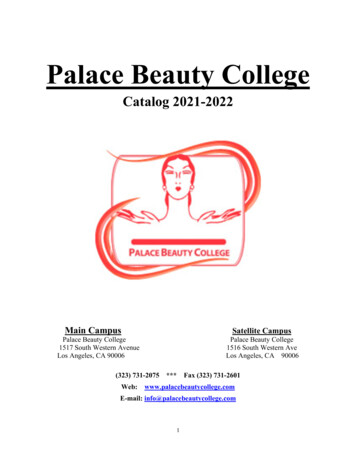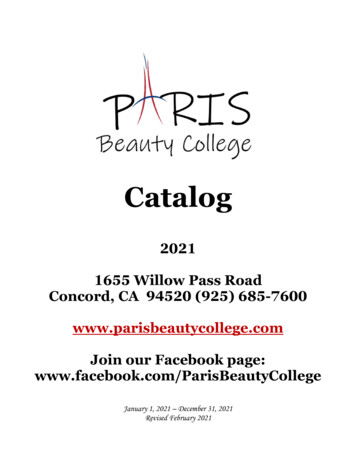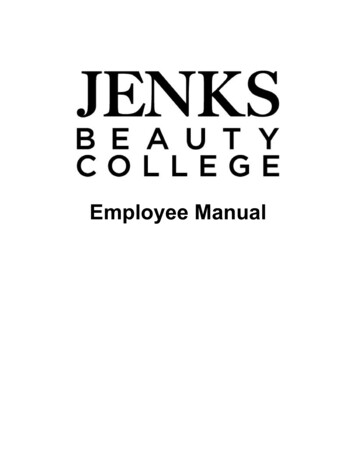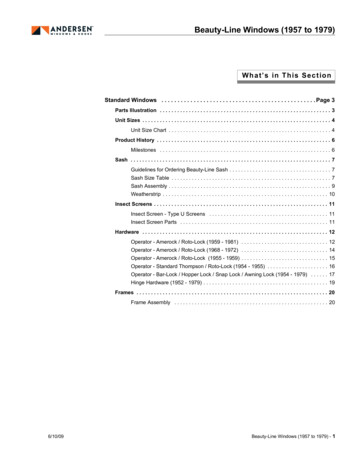
Transcription
HSNS3802 017/25/086:03 AMPage 173S T UA R T W. L E S L I E “A Different Kind of Beauty”: Scientific and ArchitecturalStyle in I. M. Pei’s Mesa Laboratory and Louis Kahn’sSalk InstituteA B S T R ACTI. M. Pei’s Mesa Laboratory for the National Center for Atmospheric Research in Boulder, Colorado, and Louis Kahn’s Salk Institute in La Jolla, California, are rare examples of laboratories as celebrated for their architecture as for their scientific contributions. Completed in the mid-1960s, these signature buildings still express thescientific style of their founding directors, Walter Roberts and Jonas Salk. Yet in commissioning their laboratories, Roberts and Salk had to work with architects as strongwilled as themselves. A close reading of the two laboratories reveals the ongoing negotiations and tensions in collaborations between visionary scientist and visionaryarchitect. Moreover, Roberts and Salk also had to become architects of atmosphericand biomedical sciences. For laboratory architecture, however flexible in theory, necessarily stabilizes scientific practice, since a philosophy of research is embedded inthe very structure of the building and persists far longer than the initial vision and mission that gave it life. Roberts and Salk’s experiences suggest that even the most carefully designed laboratories must successfully adapt to new disciplinary configurations,funding opportunities, and research priorities, or risk becoming mere architectural icons.Laboratory design, laboratory architecture, I. M. Pei, Louis Kahn, Salk Institute,National Center for Atmospheric Research, Walter Roberts, Jonas Salk, biomedical research,climate modelingKEY WOR DS:*Department of the History of Science, Medicine, and Technology, Johns Hopkins University, 3400 N. Charles Street, Baltimore, MD, 21218-2169; swleslie@jhu.edu.The following abbreviations are used: HAO, High Altitude Observatory; KC, Kahn Collection,Architectural Archives of the University of Pennsylvania, Philadelphia, PA; NBS, National Bureauof Standards; NCAR, National Center for Atmospheric Research, Boulder, CO; NIH, NationalInstitutes of Health; SP, Salk Papers, Mandeville Special Collections, UCSD, La Jolla, CA; UCAR,University Corporation for Atmospheric Research, Boulder, CO; UCAR/NCAR Archives, Boulder, CO; UCSD, University of California, San Diego; UPenn, University of Pennsylvania.Historical Studies in the Natural Sciences, Vol. 38, Number 2, pps. 173–221. ISSN 1939-1811, electronic ISSN 1939-182X. 2008 by the Regents of the University of California. All rights reserved.Please direct all requests for permission to photocopy or reproduce article content through the University of California Press’s Rights and Permissions website, http://www.ucpressjournals.com/reprintinfo.asp. DOI: 10.1525/hsns.2008.38.2.173. 173
HSNS3802 017/25/08174 6:03 AMPage 174LESLIELaboratories should look like laboratories and the scientists who will live in themmust wage war to make them so if the imprint of the scientist is to prevail. Otherwise, they must settle for a monument to an architect, which may or may nothappen to be a workable laboratory.1Laboratories measure their success by Nobel Prizes rather than Pritzker Prizes,the architectural equivalent of a Nobel. Indeed, many of the world’s mostrenowned laboratories, such as Cambridge’s Cavendish, MIT’s Rad Lab, UC’sLos Alamos, and Bell Laboratories’ Murray Hill, rank among the least architecturally distinguished. Only rarely does a laboratory earn equal acclaim forits contributions to architecture and to science.2 I. M. Pei’s Mesa Laboratoryat the National Center for Atmospheric Research (NCAR) in Boulder, Colorado, and Louis Kahn’s Salk Institute in La Jolla, California, capture the essential tension between an imaginative client and an inspired architect.3 As active collaborations between visionary scientists and architects, these laboratoriesgave concrete expression (literally) to distinctive philosophies of research. Iffounding directors Walter Orr Roberts and Jonas Salk did not exactly “wagewar” with their architects to put the appropriate scientific imprint on their laboratory, they certainly shared Winston Churchill’s belief that in science, as inpolitics, “We shape our buildings, and afterwards, our buildings shape us.”4A signature laboratory building can provide prestige, visibility, and a collective identity. Much like a corporate headquarters, it says who its denizensare, what they do, and how they do it.5 Ideally, the architecture brings the1. David Allison, “Places for Research,” International Science and Technology 1, no. 9 (1962):20–31, on 30.2. Peter Galison and Emily Thompson, ed., The Architecture of Science (Cambridge, MA: MITPress, 1999), provides a good overview but does not mention either Pei’s Mesa Lab or Louis Kahn’sSalk Institute.3. See Lucy Warner, The National Center for Atmospheric Research: An Architectural Masterpiece(Boulder, CO: UCAR, 1985). Prepared for NCAR’s 25th anniversary, An Architectural Masterpieceprovides a comprehensive history of the Mesa Laboratory and is considered an essential work onthe subject. See also Carter Wiseman, I. M. Pei (New York: Harry N. Abrams, 1990), the standard Pei biography, which includes a perceptive chapter on NCAR (pp. 72–91).4. P. Thomas Carroll first called attention to Churchill’s quote in an important unpublishedarticle on Roger Adams and his organic chemistry laboratory at the University of Illinois. P. ThomasCarroll, “Buildings and Bildung: Preliminary Speculations on How Laboratory Facilities Figurein the Evolution of Chemical Knowledge,” presented at the Department of History of Scienceand Technology, Johns Hopkins University, 1 Mar 1989.5. Alexandra Lange, “Tower, Typewriter, Trademark: Architects, Designers and the CorporateUtopia” (PhD dissertation, New York University, 2005), provides an instructive analysis of how Connecticut General, John Deere, IBM, and CBS reinvented themselves through architecture and design.
HSNS3802 017/25/086:03 AMPage 175A DIFFERENT KIND OF BEAUTY 175organization, and the organizational chart, to life both symbolically and pragmatically. Should the administration be conspicuous, or conspicuous in its absence? Will the design encourage independence or interdependence? Shouldscientists be grouped by discipline or by project? How will people and ideascirculate within? How will the building accommodate the ebb and flow of funding and fast-moving scientific fields? Questions that in old spaces gradually sortthemselves out over time become pressing issues in the design of a new laboratory. In order to explain to an architect the kind of space required, a laboratory’s leaders have to think carefully about what kind of institution it is andwhat it seeks to become, and put that vision into clear, concise language. Watching a laboratory take shape reveals what may otherwise remain hidden as scientists and architects struggle to give form and shape to their ideas and ideals.A new building becomes an opportunity to reconsider how a laboratory understands and represents itself to the scientific community and the public.6Mesa Lab and the Salk Institute offer an instructive comparison of how twoentrepreneurial scientists, in close collaboration with world-class architects, created new laboratories in their own image. Until these commissions, laboratories had rarely attracted distinguished modern architects. And when they had—the notable exceptions being Frank Lloyd Wright’s Research Tower for S. C.Johnson Wax and Eero Saarinen’s corporate laboratories for General Motors,IBM, and AT&T—the architects had such forceful personalities that the scientists essentially found themselves guests in their own homes.7 Roberts andSalk had strong ideas about the kind of places where scientists could do theirbest work, and they ended up becoming partners with their architects ratherthan working with them as conventional clients. Their laboratories offered arare opportunity to rethink traditional disciplinary boundaries and imagine6. The sociologist Thomas Gieryn has done more than anyone else to open up the architectural features of laboratory design in a series of articles on biotechnology laboratories. See ThomasGieryn, “What Buildings Do,” Theory and Society 31, no. 1 (2002): 35–75; Gieryn, “Biotechnology’s Private Parts (and Some Public Ones),” in Making Space for Science: Territorial Themes inthe Shaping of Knowledge, ed. Crosbie Smith and Jon Agar (New York: Palgrave Macmillan, 1998),281–312; and Gieryn, “Two Faces on Science: Building Identities for Molecular Biology andBiotechnology,” in Galison and Thompson, Architecture of Science (ref. 2), 423–55.7. See Jonathan Lipman, Frank Lloyd Wright and the Johnson Wax Buildings (New York: RizzoliInternational Publications, 1986); Scott G. Knowles and Stuart W. Leslie, “‘Industrial Versailles’:Eero Saarinen’s Corporate Campuses for GM, IBM, and AT&T,” Isis 92, no. 1 (2001): 1–33. RobertCumming cites the common aphorism about Wright’s residential clients in his online article,“This Bold House—Five Architects Who Defy Convention,” e (accessed 28 Mar 2008).
HSNS3802 017/25/08176 6:03 AMPage 176LESLIEnew scientific disciplines; they allowed Roberts and Salk to become architects,in a different sense, of the atmospheric sciences and of molecular and neurobiology. They had to envision an intellectual structure as ingenious and robustas any architectural plan. As sociologist Thomas Gieryn has pointed out, architecture stabilizes scientific practice, though never permanently, since a building, like the science it houses, is always under construction, negotiation, andinterpretation.8For Pei, the Mesa Lab marked his passage from journeyman to master craftsman and would convince future clients, notably the National Gallery of Artand the Louvre, that he was an architect of the first rank. For Kahn, the SalkInstitute would be his magnum opus.9 At the same time, these would be unfinished masterpieces. Budget cuts at NSF forced NCAR to abandon the southtower that Pei thought would have completed his architectural compositionand provided room for future laboratory expansion. At the Salk Institute, thesouth laboratory building remained a shell, to be fitted out gradually as fundsbecame available. Worse still, Kahn’s plans for the Institute’s Residences andfor the Meeting House, which he considered the heart of the Institute, neverleft the drawing board.10In their mid-forties when they began working with their architects, Robertsand Salk, too, learned the hard way how demanding a great building can become. For their founding directors these laboratories represented not only anenormous personal investment, but lasting legacies. They sought laboratoriesthat would reflect and reinforce an interdisciplinary style of science, at the appropriate scale. Roberts thought the secret would be small-group collaborationwith minimal administrative interference. Salk preferred the “star system,” hiring individually accomplished fellows with a track record of ignoring conventional wisdom and disciplinary boundaries, hoping that “outsiders” would bring8. Gieryn, “What Buildings Do” (ref. 6), 36.9. David Brownlee and David De Long, Louis I. Kahn: In the Realm of Architecture (New York:Rizzoli International Publications, 1991), is the most comprehensive source on Kahn, drawingfrom the Kahn Collection at the Architectural Archives of the University of Pennsylvania. Seealso Thomas Leslie, Louis I. Kahn: Building Art, Building Science (New York: George Braziller,2005). Leslie offers an architect’s view of Kahn’s major projects, drawing particular attention tostructural engineering. The noted critic Vincent Scully’s Louis I. Kahn: Makers of ContemporaryArchitecture (New York: George Braziller, 1962) is an early appreciation.10. Kent Larson and William Mitchell, Louis I. Kahn: Unbuilt Masterworks (New York: Monacelli, 2000), 48–77, using Kahn’s detailed plans and sophisticated computer modeling, providesa vivid sense of how these spaces would have looked.
HSNS3802 017/25/086:03 AMPage 177A DIFFERENT KIND OF BEAUTY 177I. M. Pei’s Mesa Laboratory, Boulder, Colorado, set against the backdropof the Flatiron Range. Note the deceptive scale, the hooded towers, and flatroofs. Source: Ezra Stoller, Esto Photographics Inc.FIG. 1a fresh perspective.11 Roberts and Salk agreed, however, that when a laboratoryexceeded a few hundred researchers and staff, it faced the law of diminishingreturns. They hoped to avoid the increasingly impersonal and bureaucratic science exemplified for Roberts by the National Bureau of Standards (NBS), whichhad built a branch laboratory in Boulder in the early 1950s, and for Salk bythe National Institutes of Health (NIH) and major medical school researchcampuses.Roberts and Salk had as much confidence in the power of place as their ownarchitects, but that confidence sometimes undermined their own goals. Roberts,who preferred a light managerial touch, expected the building itself to carrysome of the administrative load, to draw together atmospheric science by design rather than by memorandum. (Fig. 1) Paradoxically, NCAR could onlyfoster the collaborative model of atmospheric research Roberts had in mind byovercoming some of the architectural constraints designed into the laboratory.Meteorologist Robert Fleagle’s ringside seat at NCAR convinced him that “theNCAR building, designed around isolated towers, reflects [Roberts’s] vision11. Nicholas Wade, “Salk Institute: Elitist Pursuit of Biology with a Conscience,” Science 178,no. 4063 (1972): 846–49.
HSNS3802 017/25/08178 6:03 AMPage 178LESLIEfor the institution as a collection of researchers pursuing individual projects oftheir own choice. That constitutes a continuing cost that should be weightedagainst the inspiring beauty of the building and the site.”12 While that assessment downplays Roberts’s enthusiasm for interdisciplinary collaboration, it accurately underscores his assurance that the right architectural vision could advance the laboratory’s scientific mission. Similarly, the Salk Institute’s splendidisolation had to come to terms with its role in a wider web of biomedical research. As private funding faltered, the Salk Institute’s scientists had to compete with their colleagues in more conventional settings. Without financial independence, Kahn’s cloister could not provide the scientific sanctuary Salk hadenvisioned. “It has become anything but that early vision of a think tank or anInstitute for Advanced Studies,” Stanford Nobel laureate Paul Berg asserted.“They’re scratching to survive just as much as the rest of us.”13 Its architecture,however much admired, preserved an ideal increasingly at odds with contemporary scientific practice.WA LT E R R O B E R T S ’ S “ACA D E M I CA L V I L L AG E ”Much as Thomas Jefferson envisioned his University of Virginia as an “academical village,” for Roberts the guiding metaphor for NCAR was the village,a self-directed community of peers. NCAR would never be a single laboratoryin the traditional sense, though plenty of bench-top science would be donethere. Rather, it would be a place that would bring together observational datafrom across the globe to be analyzed, interpreted, and built into models by theNCAR staff, visiting scientists, and even distant collaborators, a communityincreasingly linked by networks of computers. The Mesa Lab would be its village green. Roberts sought a space of complexity, communication, and creativity, something close to Jane Jacobs’s idea of an urban “ecosystem” sustainedby diversity and interdependence.14 “There are twenty different ways to go frommy office down to the chemistry laboratory,” Roberts mused, meaning endless12. Robert G. Fleagle, Eyewitness: Evolution of the Atmospheric Sciences (Boston: AmericanMeteorology Society, 2001), 86. Thanks to Joseph Bassi for alerting me to this reference.13. Quoted in Ann Gibbons, “The Salk Institute at a Crossroads,” Science 249, no. 4967(1990): 360.14. Jane Jacobs, The Death and Life of Great American Cities (New York: Modern Library, 1993),xvi–xvii. See also Peter Hall, Cities in Civilization (New York: Pantheon, 1998). Hall makes a similar point about cities as “crucibles of culture” (pp. 193–97).
HSNS3802 017/25/086:03 AMPage 179A DIFFERENT KIND OF BEAUTY 179opportunities for serendipitous encounters and exchanges. Like Jacobs, he hadmore confidence in grassroots community building than in master plans.Roberts’s early career as a solar astronomer fundamentally shaped his ideasabout how science should be organized and practiced. In 1940, when Robertswas a graduate student in astronomy at Harvard, his advisor sent him to Climax, Colorado, to set up a solar observatory. There Roberts mapped the corona’schanging patterns of brightness, its rotation, and its prominences, the spectacular arch-shaped eruptions most visible in the corona. Most significantly, afew days later he observed the unexpected connection between a bright coronaon the east limb of the sun and radio interference in the earth’s ionosphere, afinding of sufficient military importance to keep him at Climax for the rest ofthe war as an army of one in the battle for clear communication. After the war,Roberts established the High Altitude Observatory (HAO), with improved instruments at Climax and headquarters in Boulder, to take advantage of connections with the University of Colorado.15 He made an influential ally of Edward Condon, the newly appointed head of the NBS, whom he lobbied hard,and successfully, to relocate the NBS’s Electronics and Central Radio Propagation Laboratories to Boulder.16 Architect William Pereira’s design for NBS,however, with its endless corridors, sprawling wings, cookie-cutter offices, laboratory modules, and indifference to local geography, became for Roberts aclassic example of the pitfalls of a government-issued laboratory.Roberts had an ambitious research agenda for HAO, but only a shoestringbudget. He turned out to be an effective salesman, and by 1960 HAO had ahome of its own on campus in a building adjoining the Sommers Bausch Observatory, which also housed the department of astro-geophysics, which Robertshad founded. Roberts believed that for laboratories, small was beautiful.Arranged on a rectangular plan with offices on the exterior, laboratories onthe interior, and an encircling corridor in between, the HAO building offeredan ideal compromise between the dilapidated Temporary Building 8, HAO’sfirst location (which Roberts liked because he could drill through the floorsand knock holes in the walls), and something as overwhelming as the NBS.The HAO building comfortably accommodated its scientific staff of fourteen15. Elizabeth Lynn Hallgren, The University Corporation for Atmospheric Research and theNational Center for Atmospheric Research, 1960–1970: An Institutional History (Boulder, CO: UCAR,1974), 58.16. Joseph Bassi, “From a ‘Scientific Siberia’ to ‘AstroBoulder’: The Beginning of the Transformation of Boulder, Colorado into a City of Knowledge,” unpublished, traces in detail Roberts’srole in the relocation of the NBS laboratory.
HSNS3802 017/25/08180 6:03 AMPage 180LESLIEPhDs and forty-five staff members, plus graduate students. Roberts took a modest corner office. He favored austerity (no rugs or carpets on the floors, even inthe director’s office) and informality. He noticed that people tended to gatherin the stairwells and in the relatively short corridors, something that wouldguide his thinking about the design for NCAR.17Meteorology, always a stepchild of American science, got an enormousboost in prestige and potential funding from a 1958 National Academy of Sciences study.18 The committee members included Carl-Gustaf Rossby (the father of American meteorology), John von Neumann (who considered weathermodeling to be one of the most challenging tests for the electronic computer),and Lloyd Berkner (a key organizer of the International Geophysical Year),and their report urged serious consideration of a “national effort in atmospheric research.” A subsequent study by top academic meteorologists, organized as the University Committee on Atmospheric Research, later theUniversity Corporation for Atmospheric Research (UCAR), drafted a “BlueBook” that set out a detailed research agenda. It included a generic, stripmall-style design for a National Institute for Atmospheric Research.19 Whowould head it, where it should be located, and how it would be organized remained open questions.20Roberts, a UCAR trustee-at-large, had followed the planning process closely,discussed it with his HAO board, and made no real secret of his ambition tohead the proposed institute, under the right conditions. UCAR’s site committee had narrowed its search to four general regions—Colorado, Ohio, NewYork, and North Carolina—but understood that the preferences of the director would trump any other considerations. The nominations committee, meanwhile, having unsuccessfully courted James Van Allen (University of Iowa) andHerbert Friedman (Naval Research Laboratory) discovered that “Dr. Robertsis the only one on our top list of four candidates who really wants the job.He is ready to start to work for us at once. He is at a very productive age,17. Mary Andrews and Ed Wolff, interview by Stuart W. Leslie, 20 Jan 2005.18. Hallgren, Institutional History (ref. 15), 66–67; Karl Hufbauer, Exploring the Sun: Solar Science since Galileo (Baltimore, MD: Johns Hopkins University Press, 1991), 129–35. See also Allan A.Needell, Science, Cold War, and the American State: Lloyd V. Berkner and the Balance of ProfessionalIdeas (Amsterdam: Harwood, 2001), 297–324. Needell covers the origins and aims of the IGY.19. Hallgren, Institutional History (ref. 15), 3–23.20. “Preliminary Plans for a National Institute for Atmospheric Research,” UCAR, SecondProgress Report (Feb 1959), 75–83.
HSNS3802 017/25/086:03 AMPage 181A DIFFERENT KIND OF BEAUTY 181forty-four, and is known as a man who can accomplish the impossible.”21 Thecommittee held a long meeting with Roberts at the end of March 1960, at whichhe explained his enthusiasm for the position, but only if the board agreed tolocate NCAR in Boulder and make HAO a separate division. The committeeagreed that HAO might actually be a bonus for NCAR and could see no realliability in placing NCAR in Boulder.Only one member, P. Stewart Macaulay of Johns Hopkins, raised serious objections. Macaulay wondered if Roberts fully endorsed the fundamental principle behind NCAR, that as a national resource it should complement, ratherthan compete with, university research and address research questions beyondthe scope of a single university. He feared that Roberts mightperhaps gradually and stepwise—create a center in his own image, which is veryfar from the kind of organization and function which we had contemplated. Thething that Roberts wants to create may be just as good as that which we havebeen talking about, but I read into all of his observations the desire to have aclose, self-centered group to which scientists from the universities could gain access, if at all, only by sufferance. The idea of creating a facility at which university scientists could find facilities not available at home, and at which they couldpursue, in collaboration with resident staff, research of their own interest, seemsto have disappeared entirely.22The committee approved Roberts’s appointment as NCAR director, and NCARwould turn out to be quite different from the “close, self-centered” institutionMacaulay feared it might become.Roberts already knew exactly where NCAR should be built. He could literally see the site from his living room, a spectacular mesa in the shadow of theFlatiron range, right next to the NBS. He had long coveted the property for aColorado version of Caltech, an idea he had discussed seriously with the FordFoundation.23 Convincing UCAR to select Boulder was a mere formality.Securing the mesa would prove more challenging. Roberts and his administrative assistant Mary Andrews (Wolff ) arranged meetings with the university,21. H. R. Byers to the Board of Trustees, 15 Apr 1960, UCAR/NCAR Archives, Henry HoughtonRecords, Collection 8623, Box 1, Folder 28 April 1960.22. P. Steward Macaulay to Horace Byers, 11 Apr 1960, UCAR/NCAR Archives, HenryHoughton Records, Collection 8623, Box 1, Folder 28 April 1960.23. David DeVorkin, interview with W. O. Roberts, 28 Jul 1983, Sources for the History ofModern Astrophysics, Center for the History of Physics, American Institute of Physics, CollegePark, MD.
HSNS3802 017/25/08182 6:03 AMPage 182LESLIEthe local chamber of commerce, and the governor, urging them to move fastto finalize the site with the UCAR board. If the state offered the land to UCAR,Boulder would have a clear advantage, since it already met all of the other criteria set by the board.24 Following a recent precedent in which the state purchased land for the Air Force Academy in Colorado Springs, the governor committed the state to purchasing the mesa if NCAR agreed to locate there. Thefinal hurdle was convincing the city of Boulder to amend its so-called “BlueLine” above which the city would not supply water or sewer lines, intended asa limit to development in the foothills overlooking Boulder. In March 1961,the city approved the exemption for NCAR, which in turn agreed to preservevirtually the entire 565-acre mesa as open, public land.25For the time being, NCAR had to make do with temporary quarters in theHAO building, in two rented buildings on the university’s east campus, andin Cockerell Hall, a converted dormitory some distance from the other sites.Meteorologist Edward Lorenz remembered his visits to Cockerell Hall as “thegolden age of NCAR.” He actually preferred its long halls, with their endlessopportunities for random encounters, to either the Pei-designed Earth SciencesBuilding at MIT, where he spent most of his career, or the Mesa Lab, where hewould be a frequent visiting researcher. A horizontal orientation, he decided,encouraged community, while a vertical orientation discouraged it: “You justdon’t see people who are three floors away from you . . . very much.”26Having settled the question of its future site, NCAR still had to decide whatkind of laboratory it should build and who should design it. Roberts, understandably, had strong opinions. He tended to look at the big picture and appreciated the building’s symbolic importance. “In keeping with the prominenceof the Table Mountain site,” he explained, “the building or buildings placedthere must also represent the dignity and importance of the Center as a national scientific laboratory. They should also express their function as researchlaboratories—they should look and feel like a research center to the public, buteven more important, to the scientists who work there.” He felt keenly that thebuilding must complement rather than compete with the natural beauty of thesite, and must be constructed from compatible materials, with proportions24. Mary Andrews to W. O. Roberts, 6 Jul 1960; Mary Andrews, Memo to Files, 12 Jul 1960,UCAR/NCAR Archives, Collection 8731, Box 1, Folder 5, Site Acquisition, 9/60–7/63.25. Warner, Architectural Masterpiece (ref. 3), 4; and Remembering Walt Roberts (Boulder, CO:UCAR, 1991), 88.26. Dialogue between Phil Thompson and Ed Lorenz, 31 Jul 1986, American MeteorologicalSociety, UCAR, 6.
HSNS3802 017/25/086:03 AMPage 183A DIFFERENT KIND OF BEAUTY 183“that do not suggest monuments, and building forms that are not reminiscentof industrial structures.”27Tician Papachristou, an architect on the university faculty, and Andrewsserved as Roberts’s architectural scouting party, setting out to discover the features an ideal laboratory should have. They started by talking with scientists atHAO and the NBS and got plenty of advice on what, and what not, to do.People insisted on quiet, private offices within convenient walking distance oftheir colleagues. The experimentalists wanted offices next door or directly acrossthe hall from their labs. Everyone expected a room with a view, natural light,and working windows, though open windows had their drawbacks. “HAO scientists would like their desks protected from the wind when their windows areopen,” they reported. “In warm weather occasional very high winds in Boulder force staff members to choose between heat and swirling papers. Valuablecomputations have been [known] to be sucked out the window.”28 They soughtadvice from Jack Bartram, a colleague at the University of Colorado who hadextensive experience in campus planning. Bartram told them that the mountains would dwarf any building NCAR could imagine, so that the architectthey chose must “be essentially humble and be a master of accommodating abuilding to a setting if he is to do a successful job here.” He urged them to consult with Pietro Belluschi, the dean of architecture at MIT, and William Wurster,Belluschi’s counterpart at Berkeley, who represented two very different schoolsof thought. Bartram gave Papachristou and Andrews frank thumbnail sketchesof possible contenders, including Philip Johnson; Minoru Yamasaki (“He woulddo a jewel-like building [that would] be extremely expensive”); and Eero Saarinen (“Each building that he does must exceed the previous one and is likely tobe full of experimental design ideas that make it difficult for a contractor tobid at a reasonable rate”).29Belluschi and Roberts met in Boulder at the end of October 1960. Robertsexplained his goal of a laboratory that would, on the one hand, encourage contemplation, and on the other, a sense of tension, and asked Belluschi for suggestions. Belluschi briefly discussed possible architects, including Louis Kahn,Richard Neutra, and Alvar Alto. Papachristou and Andrews then set out togain some first-hand impressions of current best practice. They met with ten27. W. O. Rober
"A Different Kind of Beauty": Scientific and Architectural Style in I. M. Pei's Mesa Laboratory and Louis Kahn's Salk Institute ABSTRACT I. M. Pei's Mesa Laboratory for the National Center for Atmospheric Research in Boul-der, Colorado, and Louis Kahn's Salk Institute in La Jolla, California, are rare exam-
